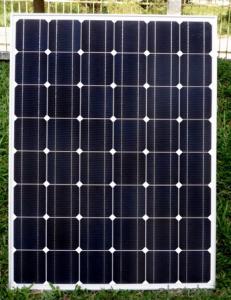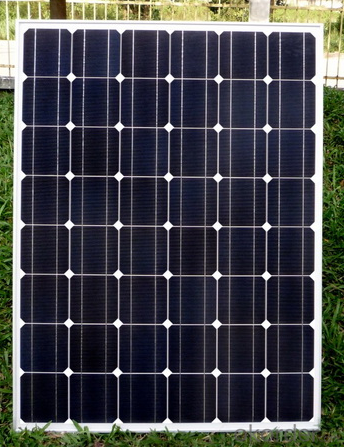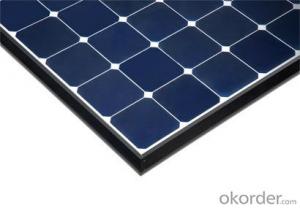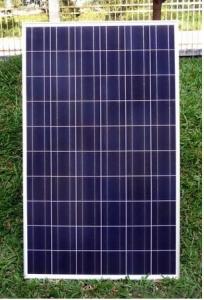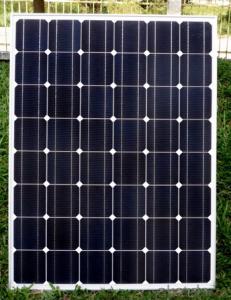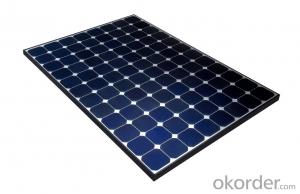Raw Solar Panels - Mono Solar Panel 105W A Grade with Cheapest Price
- Loading Port:
- Tianjin
- Payment Terms:
- TT OR LC
- Min Order Qty:
- 100 watt
- Supply Capability:
- 1000 watt/month
OKorder Service Pledge
OKorder Financial Service
You Might Also Like
Specification
Mono Solar Panel 105W A Grade with Cheapest Price
product description
Strings of series cells are usually handled independently and not connected in parallel, though as of 2014)individual power boxes are often supplied for each module, and are connected in parallel. Although modules can be interconnected to create an array with the desired peak DC voltage and loading current capacity, using independent MPPTs (maximum power point trackers) is preferable. Otherwise, shunt diodes can reduce shadowing power loss in arrays with series/parallel connected cells.[citation needed]
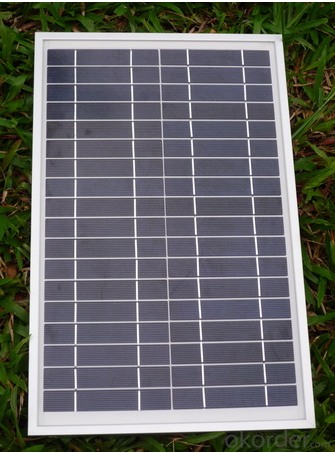
Feature
The modules use high-quality imported polycrystalline or Polycrystalline solar panel;
Enclosed by high-rigidity tempered glass, with excellent light transmittance and output performance;
Surface treated with reflection-reducing process, increasing the light absorption.
Back sealed with anti-aging EVA, resistant from moisture and corrosion.
The efficiency of our Polycrystalline solar cell is over 17%, and polycrystalline panel is over 16%. We stipulate, the allowance of each panel’s rated power has to be positive. Each panel is strictly tested before leaving the factory.
Our solar panel is designed with a lifetime of 25 years, and guaranteed that the power decline less than 10% within 10 years, and 20% within 20 years.
Packaging
28pcs into one box 48pcs into one pallet.
Delivery
20 days after received full payment
Payment term
LC&TT
- Q: How do solar panels perform in extreme temperatures?
- Solar panels can still generate electricity in extreme temperatures, but their performance may be slightly affected. High temperatures can cause a decrease in efficiency, as the heat reduces the panel's ability to convert sunlight into electricity. However, modern solar panels are designed to withstand a wide range of temperatures, and their efficiency losses are generally minimal. In extremely cold temperatures, solar panels can actually perform slightly better due to the improved conductivity of the solar cells. Overall, while extreme temperatures can have a small impact on solar panel performance, they are still a reliable and efficient source of renewable energy in various weather conditions.
- Q: How do solar panels affect the grid during times of high electricity demand?
- Solar panels can help alleviate the strain on the grid during times of high electricity demand by generating clean and renewable energy directly from the sun. When solar panels produce surplus electricity, it can be fed back into the grid, increasing its supply and reducing the need for traditional power sources. This helps stabilize the grid and meet the increased demand while also reducing the reliance on fossil fuel-based power plants.
- Q: how much electricity will produce in Kwh by a 000 W solar panel in a sunny tropical area per day (good sunlight at least 0 hour a day)
- Solar okorder /
- Q: I would like to connect a solar panel to a small fan. I am not sure as to what is needed to actually quot;connectthe two together. Any help is appreciated.
- Solar panel hooked to a battery or two then to a small inverter then to your 20 volt fan ....... Or .... Solar panel to 2 volt battery wired to a 2 volt fan. I use both
- Q: Ok, so I've been having much success with the joule thief circuit and a LED, but i tried hooking it up to a small solar panel that can put out 2.5v on it's own, and can light up a white LED dimly by it self to the joule thief and it will not work ....my question is why? I already trouble shooted it, the circuit is not the problem, is it the amount of amps the small solar panel is capable of? not enough?
- Solar panels convert light energy to electrical energy with an efficiency of around 5%. A SMALL solar panel will only produce a small amount of power (watts) your joule thief circuit wont help because as you draw more current from the solar panel the voltage will drop; and your joule thief circuit just reduces the efficiency of the whole system Try adding another solar cell in series to get more voltage and more power.
- Q: Can solar panels be used in areas with high levels of lightning activity?
- Yes, solar panels can be used in areas with high levels of lightning activity. However, it is important to install proper lightning protection systems and grounding measures to minimize the risk of damage or electrical surges caused by lightning strikes.
- Q: How much energy can a solar panel produce in a day?
- The amount of energy a solar panel can produce in a day depends on various factors such as the size and efficiency of the panel, geographic location, weather conditions, and orientation towards the sun. On average, a standard solar panel can generate between 4 to 6 kilowatt-hours (kWh) of electricity per day. However, this can vary significantly and may be higher or lower depending on the aforementioned factors.
- Q: Hi everyone, I am a novice in solar energy system. I want to know if I am on the right track. Recently I bought a 30 W solar panel, 5 Amp controller, and a 22 Ah battery, how many watts and what kind of INVERTER do I need? I did an research some said 50 W and some said 300 W. And am I right on the 5 amp controller and 22 Ah battery to provide larger output of electric, or the higher the # the greater output for 30 W solar panel?Really appreciate for anyone who help!!!
- must be one of the place who's place have sun
- Q: How Is heat From the Sun Transferred into Currents From solar Panels? (Explain Deeply Please)
- This okorder /
- Q: Are the solar panels on the roof just a gimik to get all the tree huggers to buy it, or are they actually a good, efficent design?
- The solar panels run the fan to remove hot air from the car. They do about the same amount of cooling that cracking the windows and using a heatshield over the windshield--that is they keep the interior of the car about the same as the exterior without draining the 2V battery. One problem I have with the solar panels is that they come with a moonroof. The other problem I have with them is that to get them you have to give up the additional safety features because Toyota won't put both the high tech safety features and the solar panels on the same car. So is it a good design? Well, nothing with a sun/moonroof is a good design IMHO, but that's the power of advertising for you. In that it runs a fan without draining the 2V battery, yes that part's good. Having to give up the high tech safety features to get it makes it a non-starter for me (and I live where it gets plenty hot so I could really use the fan).
Send your message to us
Raw Solar Panels - Mono Solar Panel 105W A Grade with Cheapest Price
- Loading Port:
- Tianjin
- Payment Terms:
- TT OR LC
- Min Order Qty:
- 100 watt
- Supply Capability:
- 1000 watt/month
OKorder Service Pledge
OKorder Financial Service
Similar products
Hot products
Hot Searches
